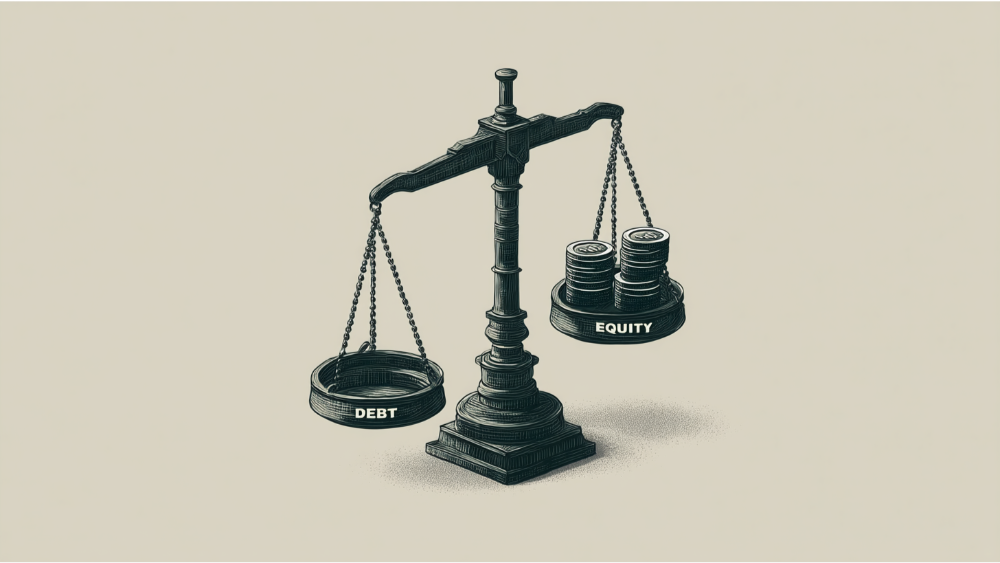When evaluating a business or making investment decisions, understanding how a company manages its debt and equity is critical. One of the most widely used metrics for gauging a company’s financial health is the debt to equity ratio. For high-net-worth investors and business owners alike, this ratio helps clarify how a business finances operations, how much debt it carries, and whether its capital structure is sustainable in a changing economy.
What Is the Debt to Equity Ratio?

The debt to equity ratio compares a company’s total liabilities to its shareholders’ equity, showing how much debt is used to finance operations relative to what the owners have invested. It is one of the most reliable indicators of a company’s financial health, and it reveals how reliant a business is on borrowing to support growth, maintain cash flow, or cover expenses.
How to Calculate the Debt to Equity Ratio
The formula is straightforward:
Debt to Equity Ratio = Total Liabilities ÷ Shareholders’ Equity
This calculation includes both short term debt (like accounts payable, lines of credit, and short-term loans) and long term debt (such as mortgage, bonds payable, or structured corporate loans). Shareholders’ equity represents the residual interest in the assets after deducting all liabilities.
For example, if a company has $2 million in total debt and $1 million in equity, the debt to equity ratio is 2.0. That means the company uses two dollars of debt for every dollar of equity.
Why the Debt to Equity Ratio Matters
The debt to equity ratio is a key measure of leverage, risk, and a company’s ability to repay its financial obligations. A high ratio signals that a company is financing a significant portion of its operations through borrowed money. While this may not always be a bad thing, it increases exposure to higher interest rates, repayment pressure, and potentially even bankruptcy in unfavorable conditions.
Conversely, a very low ratio may suggest that a business is underutilizing available debt to fuel growth opportunities, which can negatively impact its competitiveness or return on equity. As with most financial indicators, context is critical.
What Is a Good Debt to Equity Ratio in 2025?

In general, a debt to equity ratio between 0.5 and 1.5 is considered good across most industries. However, what is considered good depends heavily on the industry, the company’s growth stage, revenue predictability, and other factors like cash reserves and access to credit.
- Low ratio (below 1.0): Indicates conservative financial management and low leverage. These businesses typically have strong internal funding and consistent earnings.
- Balanced ratio (1.0 to 1.5): Suggests the company is using debt strategically without overextending.
- High ratio (above 2.0): May reflect too much debt or high financial risk, unless supported by reliable cash flow and capital efficiency.
Industry-Specific Debt to Equity Standards
Different sectors operate under different leverage norms. The company’s balance sheet must be assessed in the context of the business depends on recurring revenues, asset structures, and capital needs.
- Utilities and banks: These businesses often carry high levels of debt, with D/E ratios of 2.0 or higher. Stable revenues and regulated markets support this structure.
- Technology and professional services: These asset-light sectors usually maintain lower leverage. Ratios under 1.0 are common due to less reliance on physical assets.
- Real estate and construction: These sectors often show high debt to equity ratios because properties and long-term assets justify long-term financing through mortgage and structured loan facilities.
Debt to Equity vs. Debt Ratio
While they are often confused, the debt ratio and the debt to equity ratio are not the same.
- Debt to equity compares liabilities to shareholders’ equity.
- Debt ratio compares liabilities to total assets, showing how much of a company’s asset base is financed through debt.
For example, if a company has $2 million in liabilities and $5 million in assets, its debt ratio is 0.4 or 40 percent. Understanding both ratios can provide a more comprehensive view of financial stability.
Interpreting the Ratio: What High or Low Really Means

A high debt to equity ratio can be a sign of either growth investment or excessive financial risk. It might indicate that a company is expanding quickly using borrowed funds. But in the absence of adequate cash flow, too much leverage can lead to missed payments, loss of confidence from lenders, and even bankruptcy.
A low ratio, while generally safer, can suggest the company is not taking full advantage of favorable borrowing conditions or is overly conservative, missing out on ways to grow and increase shareholder value.
Real-World Example: Debt to Equity Ratios in 2025
Let’s look at some real companies to understand how these ratios apply:
Example 1: Apple Inc.
Apple carries a debt to equity ratio of under 2.0. Despite its massive cash reserves, Apple issues new debt strategically to finance share buybacks and maintain capital flexibility. Its cash flow and earnings allow it to comfortably manage interest payments and maintain confidence among investors and lenders.
Example 2: Target Corporation
Target’s debt to equity ratio hovers around 1.0, reflecting a balanced structure. The company uses debt to finance operations, expand store locations, and manage inventory while preserving equity. This moderate debt load supports growth without excessive risk.
Example 3: Utility Companies
Utility companies like Duke Energy or Southern Company often report D/E ratios of 2.5 or higher. These high-leverage businesses are backed by regulated revenue models, giving banks and investors confidence in their ability to meet financial obligations.
Other Factors That Influence the Debt to Equity Ratio
While the ratio itself is important, understanding what drives it is equally critical.
- Short term vs. long term debt: High short-term obligations can signal liquidity risk.
- Business model and revenue consistency: Stable income reduces the danger of default.
- Access to capital: A company with strong credit and good banking relationships may afford higher leverage.
- Equity changes: Share repurchases or losses can lower equity, inflating the ratio without new debt being issued.
Managing Debt to Equity for Long-Term Stability

Good management teams constantly monitor and adjust their capital structure. They weigh the costs of borrowing against potential earnings growth and weigh risks of overleveraging against the inefficiencies of holding too much equity.
Using Debt to Unlock Growth
Responsible borrowing can amplify returns. Strategic use of debt allows businesses to invest in new markets, develop products, or upgrade infrastructure. But this only works if cash flow is strong enough to service that loan.
Avoiding the Pitfalls of Too Much Debt
When debt exceeds manageable levels, companies can lose financial flexibility, face rising borrowing costs, and risk defaulting on payments. Too much debt can also limit access to future capital, discourage investors, and erode confidence in the company’s leadership.
What Investors Should Watch For
When evaluating a company or private investment opportunity, pay close attention to:
- How debt compares to total assets and cash reserves
- Trends in the ratio over time, rising debt levels with flat or declining equity is a concern
- The purpose of the debt, financing expansion is different from covering operating losses
- Liquidity and interest coverage, can the business afford its debt under stress?
Towerpoint Wealth regularly analyzes debt to equity and related metrics to guide client investment decisions. We focus on whether leverage aligns with business fundamentals and how it might evolve under different economic conditions.
Frequently Asked About Debt to Equity Ratios
What is a good debt to equity ratio?
A ratio between 0.5 and 1.5 is generally considered good, depending on the industry and company’s financial health.
Is a high debt to equity ratio always bad?
Not necessarily. Some businesses operate efficiently with high ratios due to stable revenues or asset-backed financing. The key is whether they can manage payments and maintain cash flow.
What’s the difference between debt ratio and debt to equity ratio?
The debt ratio measures total amount of liabilities against the total amount of assets, while debt to equity compares liabilities to shareholder equity. Both are useful to measure risk and financial stability.
Can a low debt to equity ratio be a bad thing?
Yes. A very low ratio may mean a company is under-leveraged, missing out on growth opportunities by not using low-cost loans when appropriate.
How does the ratio affect investors?
It helps investors assess risk, understand how much debt a company is using to fuel its operations, and whether that structure is sustainable over time.
Conclusion: Evaluating the Debt to Equity Ratio with Strategic Insight
Understanding what is a good debt to equity ratio is critical to analyzing any business, public or private. This metric provides a window into how a company manages its capital, whether it can meet obligations, and how aggressive or conservative its strategy may be. But the ratio is only one part of the story. Context matters: industry standards, the company’s cash flow, use of debt, and market conditions all significantly impact the meaning of this number.
At Towerpoint Wealth, we help clients navigate complex financial data, including leverage metrics like the debt to equity ratio, to make informed decisions about where to invest, how to manage risk, and how to preserve and grow wealth across market cycles.
Want to evaluate your portfolio’s exposure to debt-driven businesses or assess your own business’s financial structure? Schedule a strategic consultation with Towerpoint Wealth today.




